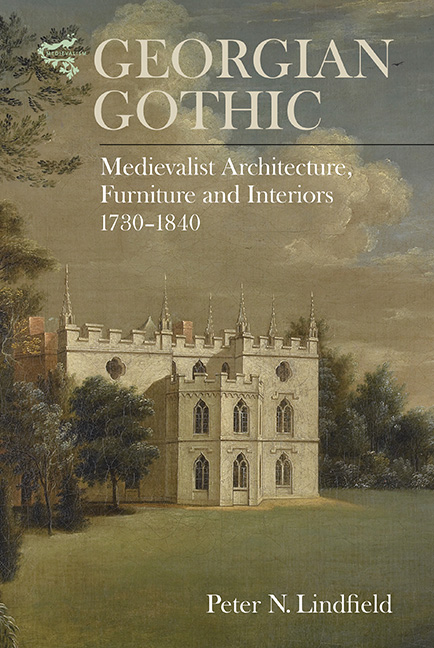Book contents
- Frontmatter
- Dedication
- Miscellaneous Frontmatter
- Contents
- List of Illustrations
- Acknowledgements
- Introduction: the Gothic Aesthetic in Britain and British Furniture, 1730–1840
- 1. Understanding Gothic Architecture in Georgian Britain
- 2. Creation of Classical Gothic Architecture, Furniture and Interiors
- 3. High Fashion and Fragments of the Past: the Omnipresence of Rococo Gothic
- 4. Fluctuating Tastes: Gothic in Later Eighteenth-century Britain
- 5. The ‘Chaos of Modern Gothic Excrescences’: Regency to Revolution
- Conclusion
- Appendix
- Bibliography
- Glossary
- Index
- Miscellaneous Endmatter
1. - Understanding Gothic Architecture in Georgian Britain
Published online by Cambridge University Press: 25 October 2017
- Frontmatter
- Dedication
- Miscellaneous Frontmatter
- Contents
- List of Illustrations
- Acknowledgements
- Introduction: the Gothic Aesthetic in Britain and British Furniture, 1730–1840
- 1. Understanding Gothic Architecture in Georgian Britain
- 2. Creation of Classical Gothic Architecture, Furniture and Interiors
- 3. High Fashion and Fragments of the Past: the Omnipresence of Rococo Gothic
- 4. Fluctuating Tastes: Gothic in Later Eighteenth-century Britain
- 5. The ‘Chaos of Modern Gothic Excrescences’: Regency to Revolution
- Conclusion
- Appendix
- Bibliography
- Glossary
- Index
- Miscellaneous Endmatter
Summary
There is no state of Architecture so little observed and less understood than that which we call Gothic though it is not by any means so barbarous & inelegant as is generally supposed, neither do the works of the Age we call Gothic deserve so much ridicule as the present Age are pleased to bestow upon them; for, whoever considers their works with attention will find many of them judiciously designed and admirably executed; Yet this Art is now lost and the Buildings themselves must ‘ere long fall into ruins: But if those Buildings afford any pleasure to a curious Spectator, or instruction to the Studious Architect, surely it would deserve the attention of the Curious in general to endeavour to investigate the cause of that pleasure we find in viewing those venerable buildings.
(James Essex, c.1770)THE MANY STRANDS of Gothic design in Georgian Britain, including architecture, interior decoration and furniture, were fundamentally shaped by contemporary interpretations of medieval structures. These buildings, in various states of preservation or decay, were common throughout Britain's countryside and townscapes. Some designers responded directly to published histories or explanations of medieval architecture, whilst others applied personal, and occasionally revisionist, readings of Britain's ancient structures to shape the Gothic Revival. This intellectual, cultural and aesthetic context was not stagnant, but developed dramatically and organically between 1730 and 1840; in early and mid eighteenth-century Britain medieval architecture was, on the whole, a deeply misunderstood style. There was no coherent and established way of approaching and interpreting its form and ornament, unlike that which had existed for Classical architecture following the seminal work of Vitruvius, De Architectura libri decem (c.15 BC), and subsequent architects and authors. From 1758 numerous individuals increasingly overturned this widespread ignorance of Gothic in Britain. Thomas Rickman (1776–1841), in particular, wrote An Attempt to Discriminate the Styles of English Architecture, from the Conquest to the Reformation (1817), which is a succinct and engaging assessment of medieval architecture. It completed the work started by seventeenth-century antiquaries, including John Aubrey (1626–97), by identifying and definitively outlining the stylistic evolution of medieval architecture – a system that remains valid and is still in use today.
- Type
- Chapter
- Information
- Georgian GothicMedievalist Architecture, Furniture and Interiors, 1730-1840, pp. 7 - 41Publisher: Boydell & BrewerPrint publication year: 2016



